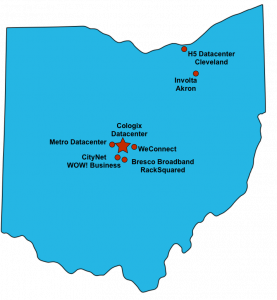Become a Member
Learn more about how you can become a member of Ohio IX and start utilizing the peering and transport benefits today.

Services and Pricing
Through Ohio IX, major telecoms, content providers and enterprises work together to efficiently exchange Internet traffic and provide mutual network access. By doing so, costs are reduced, network performance is increased and overall system robustness is enhanced.
Multilateral Peering
Traffic exchanged directly between members over shared exchange fabric utilizing Ohio IX route servers
Bilateral Peering
Traffic exchanged directly between two members of the exchange over the shared exchange fabric
Direct Content Access
Connect directly into content you specify.
All peering services are for unicast traffic with exception of broadcast ARP packets and multicast ICMPv6 Neighbor Discovery packets. Ohio IX provides complimentary reporting tools that allow members to monitor performance and traffic metrics online on a 24×7 basis with automated alarms to both Ohio IX’s 24×7 on-site and members NOCs.
Ohio IX offers its members complimentary use of redundant Route Servers to enhance scalability with multi-member peering. Route Servers provide aggregation of BOP maps from all participating peers allowing peers to connect to a single point (Ohio IX’s Route Servers) instead of each peer connecting with every peer separately. Thus, Route Servers provide substantially simplified routing setup and the advantages of Route Servers grow as the number of peering connections increase — without the use of Route Servers, a mesh of N peers would require N-1 connection for each peer.
By advertising route(s) to Route Servers, members give explicit permission allowing traffic to be forwarded to them via advertised route(s), individual members may filter both outbound and inbound traffic via this interconnect.


Annual Membership
- $1,000 for senior members, includes use of single port (1G or 10G) on the public peering VLAN
- $2,500 for senior members, includes use of single port (40G or 100G) on the public peering VLAN
- $500 for associate members
Membership Renewal for 2022
- Renewal for existing Senior Member of Record using a 1G or 10G port: $1,000
- Renewal for existing Senior Member of Record using a 40G or 100G port: $2,500
- Renewal for existing Associate Member of Record: $500



Additional Ports
- Additional 1G or 10G port: $500 annually
- Additional 40G or 100G port: $1,500 annually
Charges at Cologix for Interconnects to Ohio IX
| Copper Cross Connect | Contact Cologix for current rate |
| SM Fiber Cross Connect | Contact Cologix for current rate |
| Use of Redundant Route Servers | No Charge |
| Standard Support (via Ohio IX) | $100/hour |
Become a Member
- Review the Ohio IX Code Of Regulations
- Review the Ohio IX Articles of Incorporation
- There are two types of membership to choose from: Senior or Associate. Fill out the online membership form, using the blue buttons below, that pertains to your desired membership status. Qualification for Senior Membership includes: Applicant represents that it is an operator of an Internet protocol network which has one or more direct connections to the Corporation’s switches and that it has a publicly registered Autonomous System Number (ASN), as required by the Code of Regulations of the Corporation. Note that if your organization does not meet the definition of a senior member, please choose associate membership.
- If you have questions or trouble filling out the online forms, please contact info@ohioix.net.
- After your membership is submitted online, someone from Ohio IX will contact you to complete the process. Additionally, someone from Cologix will contact you to setup your cross connect(s) into Ohio IX. If you have any other questions, please contact us.
- Alternately, if you prefer to mail or email in the membership application, the Senior Membership form can be downloaded here and the Associate Membership form can be downloaded here. Once complete, the form should be emailed to: info@ohioix.net or mailed to the P.O. Box on our Contact page.

